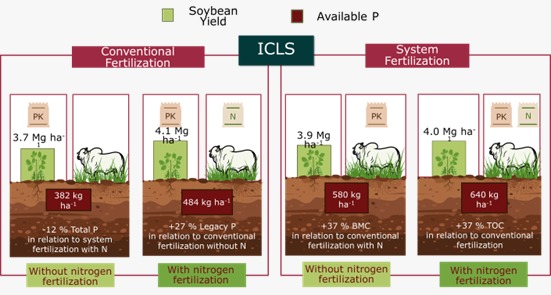Fertilization strategies to improve phosphorus availability and soil quality in integrated crop-livestock system in tropical soils
13/Oct/2025
ABSTRACT Exploring different fertilization strategies in an integrated crop-livestock system (ICLS) can enhance soil phosphorus (P) availability and improve soil quality, ultimately leading to higher yield. This study aimed to evaluate different fertilization strategies in ICLS and their effects on soil P fractions, soil quality and soybean grain yield in a tropical soil. Initiated in 2019, the experiment tested four fertilization strategies: 1) Conventional fertilization with P and K applied at soybean sowing (CF); 2) CF + N fertilization in […]
Phosphorus Forms in Sediments as Indicators of Anthropic Pressures in an Agricultural Catchment in Southern Brazil
21/Nov/2017
ABSTRACT Phosphorus (P) fractionation is a suitable procedure to ascertain P lability in sediments and is able to distinguish sources of P under different soil management practices in a catchment. Brazil is the second largest producer and the largest exporter of tobacco in the world. Inadequate management of cultivated areas exposes the soil to erosion processes, accelerating the transfer of sediment and P to water bodies, which leads to eutrophication. We evaluated the P forms in suspended sediments collected at […]
Animal manure phosphorus characterization by sequential chemical fractionation, release kinetics and 31P-NMR analysis
01/Oct/2014
Phosphate release kinetics from manures are of global interest because sustainable plant nutrition with phosphate will be a major concern in the future. Although information on the bioavailability and chemical composition of P present in manure used as fertilizer are important to understand its dynamics in the soil, such studies are still scarce. Therefore, P extraction was evaluated in this study by sequential chemical fractionation, desorption with anion-cation exchange resin and 31P nuclear magnetic resonance (31P-NMR) spectroscopy to assess the […]
Congo grass grown in rotation with soybean affects phosphorus bound to soil carbon
01/Jun/2014
The phosphorus supply to crops in tropical soils is deficient due to its somewhat insoluble nature in soil, and addition of P fertilizers has been necessary to achieve high yields. The objective of this study was to examine the mechanisms through which a cover crop (Congo grass – Brachiaria ruziziensis) in rotation with soybean can enhance soil and fertilizer P availability using long-term field trials and laboratory chemical fractionation approaches. The experimental field had been cropped to soybean in rotation […]
Phosphorus transformation in poultry litter and litter-treated Oxisol of Brazil assessed by 31P-NMR and wet chemical fractionation
01/Nov/2012
Large quantities of poultry litter are being produced in Brazil, which contain appreciable amounts of phosphorus (P) that could be of environmental concern. To assess the immediate environmental threat, five poultry litters composed of diverse bedding material were incubated for 43 days under greenhouse conditions. The litters consisted of: coffee bean husk (CH); wood chips (WC); rice husk (RH); ground corn cobs (CC) and ground napier grass (NG) (Pennisetum purpureum Schum.), in which the change in forms of soluble P […]
Forms of inorganic phosphorus in soil under different long term soil tillage systems and winter crops
01/Feb/2012
The cultivation of crops with different capacity of P uptake and use under long-term soil tillage systems can affect the distribution of P cycling and inorganic forms in the soil, as a result of higher or lower use efficiency of P applied in fertilizers. The purpose of this study was to evaluate the effect of long-term cultivation of different winter species under tillage systems on the distribution of inorganic P forms in the soil. In 1986, the experiment was initiated […]
Soil phosphorus dynamics and availability and irrigated coffee yield
01/Apr/2011
Research data have demonstrated that the P demand of coffee (Coffea arabica L.) is similar to that of short-cycle crops. In this context, the objective of this study was to evaluate the influence of annual P fertilization on the soil P status by the quantification of labile, moderately labile, low-labile, and total P fractions, associating them to coffee yield. The experiment was installed in a typical dystrophic Red Latosol (Oxisol) cultivated with irrigated coffee annually fertilized with triple superphosphate at […]
Phosphorus fractions and their relationship with phosphorus uptake by flooded rice in Rio Grande do Sul
01/Apr/2009
Soils used for flooded rice in the State of Rio Grande do Sul, Brazil, evolved from different materials which led to variations in the distribution of P fractions. In order to quantify the phosphorus fractions and relate them with the P uptake by rice plants, a greenhouse experiment was conducted with four soil samples where rice was grown for 35 days, without and with the addition of 39.30 mg kg-1 P. In the soil samples before cultivation, the available P was determined (Mehlich-1) […]
Soil phosphorus forms after successive pig slurry application in a native pasture
01/Aug/2008
The swine industry generates large amounts of pig slurry (PS), which is reused as agricultural fertilizer. However, if applied at excessive rates, pig slurry becomes a severe environmental pollutant. The objective of this study was to evaluate forms of soil phosphorus accumulation after successive swine manure applications. The experiment was installed in 1995, in an area of native pasture. Rates of 0, 20 and 40 m3 ha-1 of PS were applied periodically (at 45 to 60 days intervals) during five […]
Phosphorus fractions in soil cultivated with corn as affected by different phosphates and application methods
01/Apr/2008
The land use history and management of fertilization influence the soil phosphorus supply capacity. In this study, the P fractions in a Red Argisol (Ultissol) of the cerrado region were evaluated under different application methods and with phosphorus sources of different solubility, after three successive corn crops. The area had already been fertilized and cultivated in the past and remained covered with Brachiaria grass. A randomized block design with four replications was used, in a 4 x 3 + 1 factorial scheme, involving four […]

